|
Opening
surveys
Marin: Keres Defence A40
1.d4 e6 2.c4
Bb4+ 3.Bd2 a5 4.Nc3
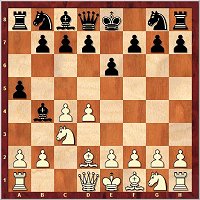 |
|
After 4.Nc3 (instead of 4.Nf3,
see Marin’s article in CBM 139) White is hoping to force Black
into capturing on c3, whereupon he can recapture with the bishop.
Mihail Marin presents various replies for Black. |
Breutigam: Scandinavian B01
1.e4 d5 2.exd5
Qxd5 3.Nc3
Qd6 4.d4
Nf6 5.Nf3 c6 6.Ne5
Nbd7
|
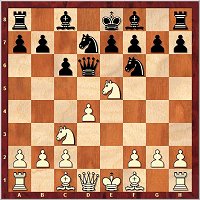
|
|
After Sergei Tiviakov had lost two games with his favourite move 3...Qd6,
theoreticians sat up and took notice. Martin Breutigam explains
in his analysis that Black has enough possibilities to improve
on his play. |
Karolyi: Pirc Defence B06
1.e4 d6 2.d4
Nf6 3.Nc3 g6 4.f3 a6 5.a4 oder
1.e4 g6 2.d4
Bg7 3.Nc3 d6 4.Be3 a6 5.a4
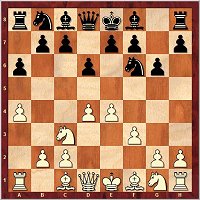 |
|
Against White’s f3 (or Be3 in the variation without ...Nf6)
strong players like to choose a setup with ...a6 and ...b5.
Tibor Karolyi suggests in his article the radical a2-a4 and in
doing so follows a game by the young Russian star Ian
Nepomniachtchi. |
Marin: Caro-Kann B15
1.e4 c6 2.d4 d5 with exd5
 |
|
In Mihail Marin’s final article on the hybrid system of
Caro-Kann and Pirc Defence the subject is lines in which, after 3.Nc3
g6, White takes on d5 early on. In addition, the author
discusses the variation with 3.exd5 cxd5 and a subsequent ...g6. |
Grivas:
Sicilian B33
1.e4 c5 2.Nf3 Nc6 3.d4 cxd4 4.Nxd4 Qb6 5.Nb3 Nf6 6.Nc3 e6 7.Be2 and
7.Bd3
(without 7...d6)
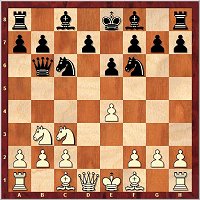 |
|
Whilst 7.Be2 is really harmless, Black needs to exert himself a bit more after 7.Bd3 in order to maintain equality. 7...Bb4, as proposed by Efstratios Grivas is interesting, though the author himself prefers to play 7...d6. |
Kritz: Two Knights Defence C57
1.e4 e5 2.Nf3
Nc6 3.Bc4
Nf6 4.Ng5 d5 5.exd5
Nd4 and
5...b5
 |
|
The two variations are related, since 5...b5 6.Bf1!
Nd4 7.c3 and 5... Nd4 6.c3 b5 7.Bf1 lead to the same position.
Leonid Kritz demonstrates convincingly that there is an advantage
for White after 7...Nxd5 8.cxd4 and that the line 5...b5 6.Bf1 h6 also fails in this respect. |
Stohl: Slav Defence D15
1.d4 d5 2.c4 c6 3.Nf3
Nf6 4.Nc3 a6 5.e3 b5 6.b3
Bg4 7.h3
Bxf3 8.Qxf3
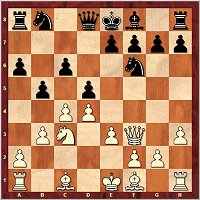 |
|
After the main move 8...e5 things become extremely sharp, but as
Igor Stohl’s analyses prove, Black can count on having good
chances of equality. If you have 4...a6 in your repertoire, you can
hardly avoid these variations. |
Ftacnik: Queen's Gambit D38
1.d4 d5 2.c4 e6 3.Nc3 Nf6 4.Nf3 Bb4 5.cxd5 exd5 6.Bg5 h6 7.Bh4 c5
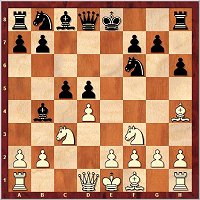 |
|
Although the variation with 6...h6 and 7...c5 has not been
played all that often so far, it seems as though White can hardly
achieve any advantage. Neither the usual 8.e3 nor the recently
tried 8.dxc5 has been successful. |
Schandorff: Semi-Slav D43
1.d4 d5 2.c4 c6 3.
Nf3
Nf6 4.
Nc3 e6 5.Bg5 h6 6.Bxf6
Qxf6 7.e3
Nd7 8.Bd3
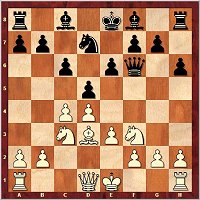 |
|
In the third part of his series on the Moscow Variation, Lars
Schandorff turns to the old lines in which Black does not go in for
the modern treatment with ...g6. But White can probably always
hope for a slight advantage. |
Krasenkow: Semi-Slav D46
1.d4 d5 2.c4 c6 3.Nf3
Nf6 4.Nc3 e6 5.e3
Nbd7 6.Bd3
Bd6
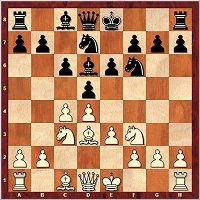 |
|
A disadvantage of 6...Bd6
is supposed to be that White reacts with a rapid e3-e4
(immediately or after castling). But as Michal Krasenkow’s analyses
show, Black can hope for level play in all lines. |
Kuzmin: Nimzo-Indian E46
1.d4
Nf6 2.c4 e6 3.Nc3
Bb4 4.e3 0-0 5.Nge2 d5 6.a3
Be7 7.cxd5
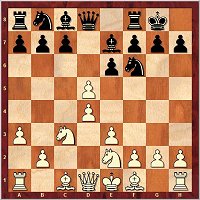 |
|
On move 6 Black more often retreats to e7 (6... Bd6
was dealt with in CBM 140). After the capture on d5, he is able
to recapture with either the knight of the pawn. In both cases
it will be hard for White to achieve any advantage. |
Postny: Nimzo-Indian E48
1.d4
Nf6 2.c4 e6 3.Nc3
Bb4 4.e3 0-0 5.Bd3 d5 6.cxd5 exd5 7.Nge2
Re8
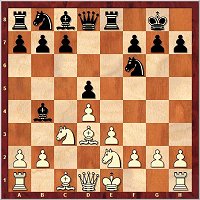 |
|
Evgeny Postny’s analyses focus above all on the move 8.Bd2.
Then Black usually retreats with his dark-squared bishop, and
analysis shows that there is a lot to be said for 8...Bd6, but
that 8...Bf8 also has its advantages. |
Schipkov: King's Indian E89
1.d4
Nf6 2.c4 g6 3.Nc3
Bg7 4.e4 d6 5.f3 0-0 6.Be3 e5 7.
Nge2 c6 8.Qd2
Nbd7 9.d5
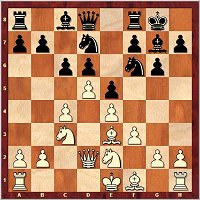 |
|
The subtle move order treated in this article allows the
exclusion of certain variations for Black. Boris Schipkov’s
analysis demonstrates an advantage for White from the position in
the diagram, and to some extent White even has a choice. |
Bojkov: King's Indian E94
1.d4
Nf6 2.c4 g6 3.
Nc3
Bg7 4.e4 d6 5.
Nf3 0-0 6.Be2
Na6 7.0-0 e5 8.Be3
Ng4 9.Bg5
Qe8 10.Re1
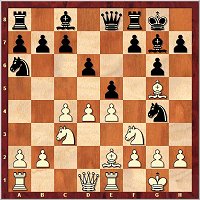 |
|
On his DVD “A modern way to play the King‘s Indian” Dejan Bojkov
draws up a program for Black which in many variations is based
on the move Nb8-a6. The position after 9...Qe8 represents one of the central lines in the Na6 King’s Indian. |
|